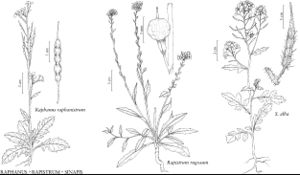Sinapis
Sp. Pl. 2: 668. 1753.
Gen. Pl. ed. 5, 299. 1754.
| Taxon | Illustrator ⠉ | |
|---|---|---|
 | Raphanus raphanistrum Rapistrum rugosum Sinapis alba | Yevonn Wilson-Ramsey Yevonn Wilson-Ramsey Yevonn Wilson-Ramsey |
Annuals [perennials]; not scapose; glabrous or pubescent. Stems erect, unbranched or branched distally. Leaves basal and cauline; petiolate or sessile; basal usually not rosulate, petiolate, blade margins usually lyrate, pinnatifid, or 1-pinnatisect or 2-pinnatisect, rarely undivided, (lobes usually coarsely dentate); cauline shortly petiolate or subsessile [sessile], blade (base not auriculate), margins often dentate or shallowly lobed [entire], rarely subentire. Racemes (corymbose, several-flowered), considerably elongated in fruit. Fruiting pedicels ascending, divaricate, or suberect [erect, reflexed], stout [slender]. Flowers: sepals usually spreading, rarely reflexed, narrowly oblong [linear], lateral pair not saccate basally; petals (spreading), yellow, obovate, claw differentiated from blade, (claw subequaling sepal, apex obtuse or emarginate); stamens tetradynamous; filaments not dilated basally; anthers oblong, (apex obtuse); nectar glands (4), distinct, lateral pair usually prismatic, rarely lobed, median pair present, (ovoid). Fruits siliques, dehiscent, sessile, segments 2, linear or lanceolate [oblong], torulose, terete or slightly flattened [4-angled, latiseptate]; (valvular segment dehiscent, longer or shorter than terminal segment, 2–5 (–12) -seeded; terminal segment indehiscent, seedless or 1- [2-] seeded, flattened and ensiform, or terete and conical or subulate, sometimes corky); valves each with 3–5 (–7) prominent, longitudinal veins, (thin or thick), glabrous or pubescent; replum rounded; septum complete; ovules 4–20 per ovary; stigma capitate, 2-lobed. Seeds uniseriate, usually plump, rarely slightly flattened, not winged, globose; seed-coat (finely reticulate [smooth or alveolate]), mucilaginous or not when wetted; cotyledons conduplicate. x = [7], 9, 12.
Distribution
Introduced; Eurasia, n Africa, also nearly worldwide
Discussion
Species 5 (2 in the flora).
Sinapis has often been merged with Brassica in North American taxonomic treatments, whereas taxonomists elsewhere maintain both genera and separate them by the number of veins of the fruit valves and the orientation of sepals. The two genera also differ in their mustard oils and seed proteins, thus supporting their maintenance (I. A. Al-Shehbaz 1985). Molecular studies (S. I. Warwick and L. D. Black 1991, 1993) have suggested that neither genus is monophyletic and, except for S. aucheri (Boissier) O. E. Schulz, the remaining taxa of Sinapis show a very close relationship to B. nigra, consistent with Linnaeus’s original description of this species as S. nigra.
Selected References
Lower Taxa
Key
| 1 | Fruiting pedicels divaricate; fruits lanceolate, hispid, trichomes of 2 types; terminal segment flattened, equal to or longer than valves, seedless. | Sinapis alba |
| 1 | Fruiting pedicels ascending to suberect; fruits linear, glabrous or pubescent, trichomes of 1 type; terminal segment terete, much shorter than valves, seedless or 1-seeded. | Sinapis arvensis |
"elongated" is not a number."thick" is not a number.